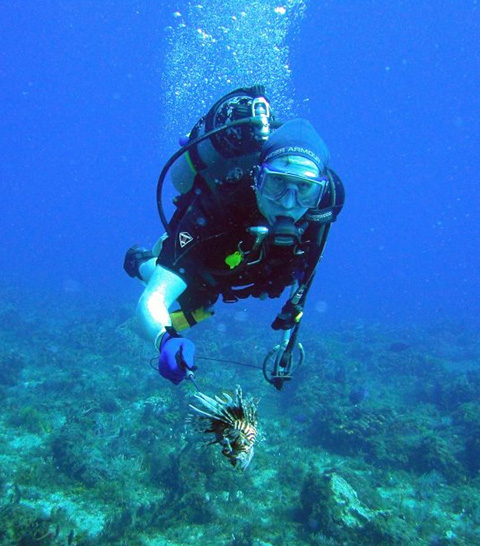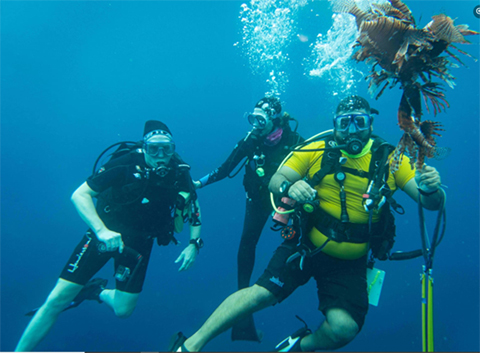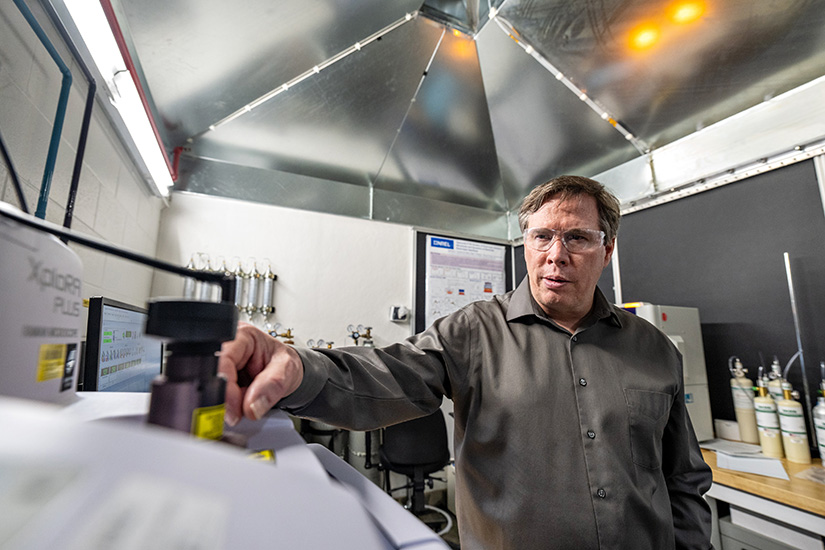Distinguished Researcher Matt Keyser Recycles Lionfish and Li-Ion Batteries
National Renewable Energy Laboratory (NREL) Distinguished Researcher Matt Keyser values recycling and upcycling—whether with used lithium-ion (Li-ion) batteries or the invasive lionfish he spears while scuba diving.

Matt Keyser in his scuba world. Photo from Matt Keyser, NREL
Both conservation practices—extracting components from Li-ion batteries and making tasty ceviche with toxic lionfish that destroy coral reefs—are key to the health of the planet in his opinion. Batteries may seem the more obvious area of interest—but for the Parker, Colorado, native who spent years as a lifeguard, the undersea world is key to the planet’s health.
He did not start out a crusader. He began scuba diving in 1993, a year after joining NREL. When he began dating his future wife, Liz, in 2002, he gently suggested that she expand upon her love of beaches to become a certified diver.
“I can’t just go on a vacation and relax on a beach,” he said. “I have to learn and experience new ways of exploring our world.”
She agreed, and they began their first scuba outing with a trip to Cozumel, Mexico—a place they return to at least once a year. Over the years, their concerns over the health of coral reefs—the nurseries of the ocean—have grown.

One cause: the lionfish, native to the Indo-Pacific area, which was introduced into the Americas by accident. Its dorsal fins are tipped with venomous spines, which makes it bad enough—but this predator also consumes massive numbers of small fish.
In Belize about year ago, Keyser noted that “the lionfish were everywhere, taking over the reef.” He and a group of friends, trained in handling these venomous creatures, speared hundreds of them for harvest. Then, they cut off the nasty spines with scissors, leaving a shrimp-like appearance whose white meat is extremely tasty. “We gave them to the chef at the resort, and he made lionfish ceviche,” Keyser laughed. “But he also took the lion’s share of the lionfish.”
Undaunted, Keyser and his wife, as well as friends, will continue their crusade.
Just as the undersea upcycling of fish makes sense, so too does this mindfulness apply in his area of professional expertise: battery development. Although trained as a mechanical engineer, he fell into the battery space when tasked with helping to set up a battery lab. From that point on, he educated himself in the manufacture of batteries as well as electrochemistry.
For his efforts in battery thermal management and safety, he has gotten a U.S. Department of Energy (DOE) Vehicle Technologies Office Distinguished Achievement Award, four R&D 100 Awards, and seven patents—three of which have been licensed.
Lately, the big thrust of his team’s research has been the recycling of Li-ion batteries and the circularity of battery materials.
“EVs (electric vehicles) are being produced. More and more people are buying them,” he said. “Once the EV batteries reach their end of life, the question is: What do you want to do with the battery packs?”
Keyser knows what is not a good solution: “Throwing them in the landfill is not an option,” he said.
The research is part of an ever-changing technology landscape. “The concept is that you have value-added products that are already in the battery such as the battery cathode—which has the most valuable metals,” he said. Further, cathodes are valuable because they take a long time to produce, with materials prepared for 8–12 hours at temperatures exceeding 800°C in order to get the proper crystalline structure and particle size for a Li-ion battery to work.
Taking a used battery means reengineering some of the degraded materials. Additionally, the materials used in today’s batteries are not the same as the ones used even five years ago—and will not be the same a year from now as the technology matures.
“We’re always playing catch-up,” Keyser said.
For example, batteries five years ago used equal components of nickel, manganese, and cobalt. Today, researchers are trying to go to higher nickel content, the NMC 8-1-1 that uses 80% nickel, 10% manganese, and 10% cobalt.
That is in part because cobalt is a critical material—most is sourced from the Democratic Republic of the Congo, where humanitarian and security issues associated with the mining are a cause for global concern. Also, much of that resource is controlled by China, which Keyser said controls about 80% of the cobalt reserves.

Looking ahead, Keyser anticipates recycling all aspects of Li-ion batteries, again focusing on circularity and sustainability. “We are starting to work on recovering anodes and binders in the battery,” he said, while continuing to recycle valuable current collector metals, such as copper and aluminum.
Four years ago, DOE’s Vehicle Technologies Office proposed investigating new Li-ion technology areas, so NREL created a proposal in that area teaming with Argonne, Idaho, and Oak Ridge national laboratories—building a partnership. Keyser hopes that such collaboration does not end there. He would support a battery hub, with national laboratories looking at various new areas of development such as multivalent chemistries using noncritical materials.
Overall, it is the enthusiasm and ingenuity of his team that helps drives research and has kept him satisfied at NREL for more than three decades. Now that he is part of the Distinguished Researchers cohort, Keyser is hoping that this group of 30 researchers can help guide NREL’s future research—while keeping it committed to principles of sustainability and the circular economy.
While he does have concerns that outside industry giants might try to lure future cadres of the best and brightest scientists into their orbits, Keyser is satisfied with the mission of NREL to lure those seeking the challenges and flexibility he has been given.
“I don’t think I would have been here this long if it weren’t for the people,” he said. But because of them and the mission, he has found fulfillment. “Why would you want to leave?”
Keyser was one of seven NREL staff to receive the Distinguished Member of Research Staff (DMRS) designation in 2023. He was recognized for “For more than 30 years of service at NREL and playing a crucial role in guiding the research, development, and strategy of NREL's battery initiatives.” To read more about Keyser and other NREL people, download a free PDF of the book “Clean Energy Innovators: NREL People Working to Change the World.”
The DMRS designation is intended to provide greater recognition to NREL researchers. It should also position individuals to work in more strategic and technical leadership roles, with continued expectations for their contributions to further enhance NREL's reputation and mission objectives.
Last Updated May 28, 2025
